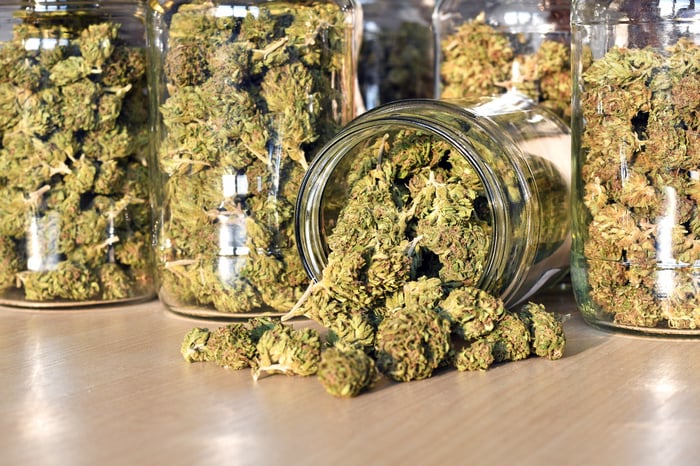If you think the stock market has been taken on a wild ride over the past four months, then you haven't been keeping an eye on the cannabis industry.
Prior to April 2019, marijuana stocks were practically unstoppable. The vast majority were up by a triple-digit or quadruple-digit percentage over the course of 12 or 24 months, and sales projections were soaring. Considering that tens of billions of dollars is sold annually in the black market, it seemed logical to Wall Street and investors that legal cannabis channels would see a rapid uptick in sales. But this hasn't been the case.
Over the past 14-plus months, marijuana stocks have been beaten to a pulp, with many losing anywhere from 50% to 90% of their value. Supply issues to our north, high tax rates in the U.S., and financing concerns have weighed on virtually all North American pot stocks. As a result Wall Street's expectations for the industry have come way down.
But despite a tempered forecast, nearly all pot stocks have a higher consensus price target from Wall Street than their closing price this past weekend. The following three popular marijuana stocks are the exception to the rule, with Wall Street's consensus price target implying an expected decline.

Image source: Getty Images.
Aurora Cannabis: Estimated downside of 22%
You might be surprised to learn that the most popular marijuana stock of them all, Aurora Cannabis (ACB 18.15%), is expected to lose 22% of its value, according to Wall Street's consensus price target.
Once on track to lead the world in legal pot production, Aurora Cannabis is a shell of what investors envisioned the company would become. After overextending itself financially, Aurora has been paring back its costs at a rapid clip. Construction at two of its largest cultivation projects has been put on hold to conserve capital, while a 1-million-square-foot greenhouse was sold. The company has also turned to layoffs to reduce costs.
At the same time, Aurora Cannabis has had limited access to traditional forms of financing. Given the numerous issues the Canadian marijuana industry is contending with in its early stages, banks have been unwilling to approve large loans. In order to raise money and close acquisitions, Aurora Cannabis has leaned heavily on using its common stock as collateral. As a result, its outstanding share count has soared from a little over 1 million in June 2014 (adjusting for the recent 1-for-12 reverse split) to probably around 113 million after the recently completed Reliva acquisition. With a $350 million at-the-market stock offering also at its disposal, Wall Street might simply be counting on future share-based dilution.
Aurora Cannabis' balance sheet also fails to inspire confidence. Currently, 51% of the total assets are classified as goodwill -- implying the company grossly overpaid for its acquisitions -- with rising inventory levels suggesting that a sizable impairment may be in the company's future.

Image source: Getty Images.
Cronos Group: Estimated downside of 31%
Perhaps the biggest surprise is that Wall Street foresees the most downside in Cronos Group (CRON 4.66%), which happens to be one of the most cash-rich cannabis stocks. Even with $1.33 billion in cash and cash equivalents, Wall Street believes Cronos Group and its $2.25 billion market cap will decline by 31%.
Similar to Aurora, Cronos Group has failed to live up to its primarily billing. In Cronos' case, it was widely expected by the investment community to leverage its equity investment/partnership with Altria Group to become the leader of cannabis vape products in Canada. However, a vape-related health scare in the U.S. in 2019, compounded with Canadian supply issues and coronavirus-related supply problems, have slowed the growth of vaping products to our north. The fact is, Altria's investment in Cronos Group hasn't yielded anything to write home about.
Making matters worse, Cronos Group isn't even a major player in the production department. Peace Naturals is capable of up to 40,000 kilos a year of output, but has had some of its square footage partially repurposed for derivatives. The result being that Cronos only generated a little over $8 million in sales in its most recent quarter. By comparison, this is a company that's lost around $155 million on an operating basis over the trailing five quarters. This means the company's cash hoard may not last as long as expected unless there's serious operational progress made soon.

Image source: Getty Images.
Canopy Growth: Estimated downside of 3%
Finally, Wall Street isn't as fond as you'd think of the largest marijuana stock in the world by market cap, Canopy Growth (CGC 15.03%). Even though Canopy has lost approximately two-thirds of its value over the past 14 months, Wall Street's consensus price target implies 3% additional downside.
Again, the surprise here might just be that Canopy Growth has the most cash of any marijuana stock (almost $2 billion Canadian), but is expected to lose value, per Wall Street. Canopy netted the vast majority of this cash from multiple equity investments, courtesy of spirits giant Constellation Brands (STZ 0.74%). Investors had expected that Canopy would use its mountain of cash to expand internationally and bolster its Canadian infrastructure. Instead, all they've witnessed is massive operating losses and more than half of the company's CA$4.5 billion cash pile disappear.
If there is a positive here for Canopy Growth, it's that former Constellation Brands Chief Financial Officer David Klein is now running things. Klein has experience in the consumer-packaged goods industry, and he's brought a no-nonsense cost-cutting approach to Canopy. To date, 3 million square feet of licensed indoor greenhouses have been permanently closed, with the company also announcing layoffs.
Nevertheless, Canopy Growth remains a work in progress. Profitability is unlikely until 2022, at the earliest, and there appears to be a growing likelihood of impairment charges regarding its goodwill and inventory levels. The reality is that Wall Street's consensus price target may still be too high given the risks that lie ahead.





